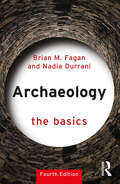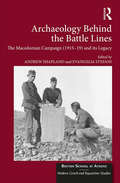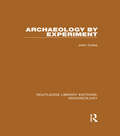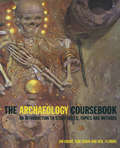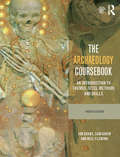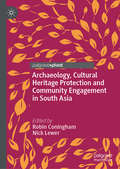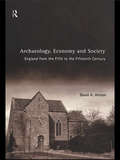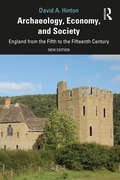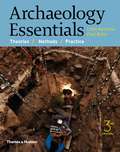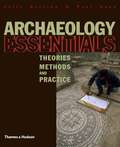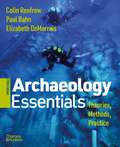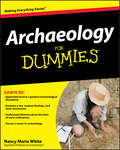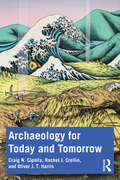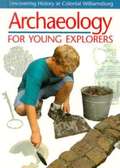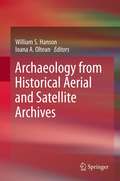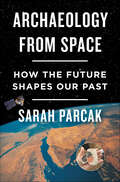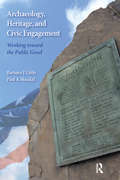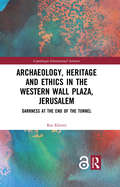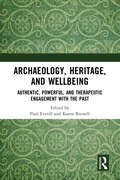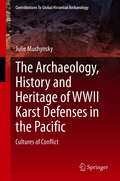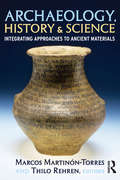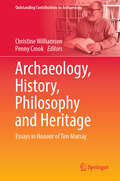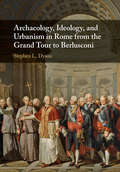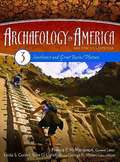- Table View
- List View
Archaeology: The Basics (The Basics)
by Brian M. Fagan Nadia DurraniArchaeology: The Basics, rewritten for this fourth edition, is a short, engaging book that takes the reader on a journey through the fascinating world of archaeology and archaeologists. Written in a non-technical style by two experienced archaeologists and writers about the past, the book begins by introducing archaeology as a unique way of studying the entire span of the human past from our origins some six million years ago to today. The authors stress that archaeology is a global study of human biological and cultural diversity. After a brief look at early archaeological discoveries, they introduce today’s multidisciplinary archaeology. Then they go on to describe the archaeological record, the archives of the past and the importance of contexts of time and space. How do we find archaeological sites and how do we explore them? Two chapters laced with examples examine these questions. Later chapters describe ancient technologies and how we study them, and the all-important subject of changing ancient environments and climate change. Zooarchaeology, flotation methods, and other ways of reconstructing ancient diet and subsistence lead us into the study of changing settlement patterns across the landscape. Next, they visit the people of the past, either as individuals or groups, calling on bioarchaeology to assist them. Two chapters discuss ancient culture change and the remarkable diversity of ancient societies, and they are followed by an exploration of the spiritual realm, the exploration of the intangible. The final chapter looks at the importance of archaeology in today’s world. Rich in numerous examples and contemporary thinking about archaeology, this book tries to answer an important question: What does archaeology tell us about ourselves? Archaeology: The Basics is essential reading for all those beginning to study archaeology and anyone who has ever questioned the past.
Archaeology Behind the Battle Lines: The Macedonian Campaign (1915-19) and its Legacy (British School at Athens - Modern Greek and Byzantine Studies #4)
by Andrew Shapland Evangelia StefaniThis volume focuses on a formative period in the history and archaeology of northern Greece. The decade following 1912, when Thessaloniki became part of Greece, was a period marked by an extraordinary internationalism as a result of the population movements caused by the shifting of national borders and the troop movements which accompanied the First World War. The papers collected here look primarily at the impact of the discoveries of the Army of the Orient on the archaeological study of the region of Macedonia. Resulting collections of antiquities are now held in Thessaloniki, London, Paris, Edinburgh and Oxford. Various specialists examine each of these collections, bringing the archaeological legacy of the Macedonian Campaign together in one volume for the first time. A key theme of the volume is the emerging dialogue between the archaeological remains of Macedonia and the politics of Hellenism. A number of authors consider how archaeological interpretation was shaped by the incorporation of Macedonia into Greece. Other authors describe how the politics of the Campaign, in which Greece was initially a neutral partner, had implications both for the administration of archaeological finds and their subsequent dispersal. A particular focus is the historical personalities who were involved and the sites they discovered. The role of the Greek Archaeological Service, particularly in the protection of antiquities, as well as promoting excavation in the aftermath of the 1917 Great Fire of Thessaloniki, is also considered.
Archaeology by Experiment (Routledge Library Editions: Archaeology)
by John ColesExperimental archaeology is a new approach to the study of early man. By reconstructing and testing models of ancient equipment with the techniques available to early man, we learn how he lived, hunted, fought and built. What did early man eat? How did he store and cook his food? How did he make his tools and weapons and pottery? Such everyday questions, besides the more dramatic mysteries associated with the monuments of Easter Island and Stonehenge and the colonization of Polynesia, can all be explored by experiment.
The Archaeology Coursebook: An Introduction To Study Skills, Topics And Methods
by Jim Grant Neil Fleming Sam GorinFirst published in 2001. Routledge is an imprint of Taylor & Francis, an informa company.
The Archaeology Coursebook: An Introduction to Themes, Sites, Methods and Skills
by Jim Grant Neil Fleming Sam GorinThis fully updated and revised edition of the best-selling title The Archaeology Coursebook is a guide for students studying archaeology for the first time. Including new methods and key studies in this fourth edition, it provides pre-university students and teachers, as well as undergraduates and enthusiasts, with the skills and technical concepts necessary to grasp the subject. The Archaeology Coursebook: introduces the most commonly examined archaeological methods, concepts and themes, and provides the necessary skills to understand them explains how to interpret the material students may meet in examinations supports study with key studies, key sites, key terms, tasks and skills development illustrates concepts and commentary with over 400 photos and drawings of excavation sites, methodology and processes, tools and equipment provides an overview of human evolution and social development with a particular focus upon European prehistory. Reflecting changes in archaeological practice and with new key studies, methods, examples, boxes, photographs and diagrams, this is definitely a book no archaeology student should be without.
Archaeology, Cultural Heritage Protection and Community Engagement in South Asia
by Robin Coningham Nick LewerExploring archaeology, community engagement and cultural heritage protection in South Asia, this book considers heritage management strategies through community engagement, bringing together the results of research undertaken by archaeologists, heritage practitioners and policy makers working towards the preservation and conservation of both cultural and natural heritage. The book highlights the challenges faced by communities, archaeologists and heritage managers in post-conflict and post-disaster contexts in their efforts to protect, preserve and present cultural heritage, including issues of sustainability, linkages with existing community programmes and institutions, and building administrative and social networks. The case-studies illustrate larger-scale projects to small micro-level engagement, across a range of geographical, political, social and economic contexts, providing a framework that links and synchronises programmes of archaeological activities alongside active community engagement. The chapters ‘Introduction’, ‘Community Engagement in the Greater Lumbini Area of Nepal: the Micro-Heritage Case-Study of Dohani’ and ‘Conclusion’ of this book are available open access under a CC BY 4.0 license at link.springer.com.
Archaeology, Economy and Society: England from the Fifth to the Fifteenth Century
by David A. HintonMany books have been written on particular aspects of medieval archaeology, or on particular parts of the period, but synthesis across the whole spectrum has not been attempted before. The aim of this book is to examine the contribution that archaeology can make to an understanding of the social, economic, religious and other developments that took place in England from the migrations of the fifth and sixth centuries to the beginning of the Renaissance, showing how society and economy evolved in that time-span.Drawing on the latest available material, the book takes a chronological approach to the archaeological material of the post-Roman period in order to emphasize the changes that can be observed in the physical evidence and some of the reasons for them that can be suggested. The environment in which people functioned and how they expressed themselves - for example in their houses and burial practices, their pottery and their clothes - show how they were constrained by social customs and economic pressures.
Archaeology, Economy, and Society: England from the Fifth to the Fifteenth Century
by David A. HintonThis book examines the contribution of archaeology to the study of the social, economic, religious, and other developments in England from the end of the Roman period at the start of the fifth century to the beginnings of the Renaissance at the end of the fifteenth century. The first edition of the book was published in 1990, and remains the only synthesis of the whole spectrum of medieval archaeology. This new edition is completely rewritten and extended, but uses the same chronological approach to investigate how society and economy evolved. It draws on a wide range of new data, derived from excavation, investigation of buildings, metal-detection, and scientific techniques. It examines the social customs, economic pressures, and environmental constraints within which people functioned; the technology available to them; and how they expressed themselves, for example in their houses, their burial customs, their costume, and their material possessions such as pottery. Their adaptation to new circumstances, whether caused by human factors such as the re-emergence of towns or changing taxation requirements, or by external ones such as volcanic activity or the Black Death, is explored throughout each chapter. The new edition of Archaeology, Economy, and Society will be essential reading for students and researchers of the archaeology of Medieval England.
Archaeology Essentials: Theories, Methods, and Practice
by Colin Renfrew Paul BahnArchaeology Essentials, already the most authoritative and accessible introduction on the market, has been updated with new discoveries, new technological innovations, revised pedagogical features, and improved illustrations. Written for today's students, Archaeology Essentials is rigorous without being over-technical and thorough without being overwhelming. The only truly global archaeology textbook available in full color, the text also provides guidance for aspiring archaeologists in the form of compelling interviews with a worldwide selection of practicing archaeologists. The third edition of Archaeology Essentials is destined to become a classic of the field.
Archaeology Essentials: Theories, Methods and Practice
by Colin Renfrew Paul BahnThis new volume has all the authority of Colin Renfrew and Paul Bahn's groundbreaking guide to all aspects of archaeology, but it has been carefully rewritten to provide a readable and compact introduction to archaeology for those new to the field. No other book of this length can match its range of essential information and explanation. Long-established techniques are carefully explained as well as exciting new methods as the authors describe the ways in which archaeologists seek to explain and interpret the remote past of humankind.
Archaeology Essentials (Fifth Edition): Theories, Methods, And Practice
by Colin Renfrew Paul Bahn Elizabeth DeMarraisStill authoritative, now thoroughly updated by new co-author Elizabeth DeMarrais This authoritative survey of archaeological practice takes a unique approach by launching each chapter with an important question that archaeologists consider. In this edition, new co-author Elizabeth DeMarrais, an expert in the archaeology of the Americas, introduces recent discoveries and advances in methodology, analysis, and interpretation, paying special attention to the contributions of women, people of color, and Indigenous communities, and to how the discipline is changing amid calls for decolonization and diversification.
Archaeology For Dummies
by Nancy Marie WhiteAn objective guide to this fascinating science of history and cultureArchaeology continually makes headlines--from recent discoveries like the frozen Copper-Age man in the Italian Alps to the newest dating of the first people in America at over 14,0000 years ago. Archaeology For Dummies offers a fascinating look at this intriguing field, taking readers on-site and revealing little-known details about some of the world's greatest archaeological discoveries. It explores how archaeology attempts to uncover the lives of our ancestors, examining historical dig sites around the world and explaining theories about ancient human societies. The guide also offers helpful information for readers who want to participate in an excavation themselves, as well as tips for getting the best training and where to look for jobs.
Archaeology for Kids: Uncovering the Mysteries of Our Past, 25 Activities (For Kids Ser.)
by Richard PanchykThis activity book features 25 projects such as making a surface survey of a site, building a screen for sifting dirt and debris at a dig, tracking soil age by color, and counting tree rings to date a find, teaches kids the techniques that unearthed Neanderthal caves, Tutankhamun's tomb, the city of Pompeii, and Tenochtitlan, capital of the Aztec empire. Kids will delight in fashioning a stone-age tool, playing a seriation game with old photographs of cars, "reading" objects excavated in their own backyards, and using patent numbers to date modern artifacts as they gain an overview of human history and the science that brings it back to life.
Archaeology for Today and Tomorrow
by Craig N. Cipolla Rachel J. Crellin Oliver J. HarrisArchaeology for Today and Tomorrow explores how cutting-edge archaeological theories have implications not only for how we study the past but also how we think about and prepare for the future. Ranging from how we understand migration or political leadership to how we think about violence or ecological crisis, the book argues that archaeology should embrace a “future-oriented” attitude. Behind the traditional archaeological gaze on the past is a unique and useful collection of skills, tools, and orientations for rethinking the present and future. Further, it asserts that archaeological theory is not only vital for how we conduct our work as archaeologists and how we create narratives about the past but also for how we think about the broader world in the present and, crucially, how we envision and shape the future. Each of the chapters in the book links theoretical approaches and global archaeological case studies to a specific contemporary issue. It examines such issues as human movement, violence, human and non-human relations, the Anthropocene, and fake news to showcase the critical contributions that archaeology, and archaeological theory, can make to shaping the world of tomorrow. An ideal book for courses on archaeology in the modern world and public archaeology, it will also appeal to archaeology students and researchers in general and all those in related disciplines interested in areas of critical contemporary concern.
Archaeology For Young Explorers: Uncovering History At Colonial Williamsburg
by Patricia Samford David L. RibblettYoung explorers can investigate Williamsburg's colonial capital along with the archaeologists. They will learn why artifacts end up in the ground, how archaeologists know where to dig, what they find when they excavate, what they do with those findings, and what they learn from their discoveries.
Archaeology from Historical Aerial and Satellite Archives
by Ioana A. Oltean William S. HansonHistorical archives of vertical photographs and satellite images acquired for other purposes (mainly declassified military reconnaissance) offer considerable potential for archaeological and historical landscape research. They provide a unique insight into the character of the landscape as it was over half a century ago, before the destructive impact of later 20th century development and intensive land use. They provide a high quality photographic record not merely of the landscape at that time, but offer the prospect of the better survival of remains reflecting its earlier history, whether manifest as earthworks, cropmarks or soilmarks. These various sources of imagery also provide an opportunity to examine from the air areas of Europe and beyond whose skies are still not open to traditional archaeological aerial reconnaissance. Tens of millions of such images are held in archives around the world, but their research potential goes very largely untapped. A primary aim of this volume is to draw to wider attention the existence, scope and potential access to historical archival aerial and satellite photographs, in order to encourage their use in a range of archaeological and landscape research. By drawing attention to this massive archival resource, providing examples of its successful application to archaeological/landscape questions, and offering advice how to access and utilise the resource, the volume seeks to bring this material to wider attention, demonstrate its huge potential for archaeology, encourage its further use and stimulate a new approach to archaeological survey and the study of landscape evolution internationally.
Archaeology from Space: How the Future Shapes Our Past
by Sarah ParcakWinner of Archaeological Institute of America's Felicia A. Holton Book Award • Winner of the Phi Beta Kappa Prize for Science • An Amazon Best Science Book of 2019 • A Science Friday Best Science Book of 2019 • A Kirkus Reviews Best Nonfiction Book of 2019 • A Science News Best Book of 2019 • Nature's Top Ten Books of 2019 "A crash course in the amazing new science of space archaeology that only Sarah Parcak can give. This book will awaken the explorer in all of us." ?Chris Anderson, Head of TEDNational Geographic Explorer and TED Prize-winner Dr. Sarah Parcak gives readers a personal tour of the evolution, major discoveries, and future potential of the young field of satellite archaeology. From surprise advancements after the declassification of spy photography, to a new map of the mythical Egyptian city of Tanis, she shares her field’s biggest discoveries, revealing why space archaeology is not only exciting, but urgently essential to the preservation of the world’s ancient treasures.Parcak has worked in twelve countries and four continents, using multispectral and high-resolution satellite imagery to identify thousands of previously unknown settlements, roads, fortresses, palaces, tombs, and even potential pyramids. From there, her stories take us back in time and across borders, into the day-to-day lives of ancient humans whose traits and genes we share. And she shows us that if we heed the lessons of the past, we can shape a vibrant future. Includes Illustrations
Archaeology, Heritage, and Civic Engagement: Working toward the Public Good
by Barbara J Little Paul A ShackelThe definition of “public archaeology” has expanded in recent years to include archaeologists’ collaborations with and within communities and activities in support of education, civic renewal, peacebuilding, and social justice. Barbara Little and Paul Shackel, long-term leaders in the growth of a civically-engaged, relevant archaeology, outline a future trajectory for the field in this concise, thoughtful volume. Drawing from the archaeological study of race and labor, among other examples, the authors explore this crucial opportunity and responsibility, then point the way for the discipline to contribute to the contemporary public good.
Archaeology, Heritage and Ethics in the Western Wall Plaza, Jerusalem: Darkness at the End of the Tunnel
by Raz KletterThis volume is a critical study of recent archaeology in the Western Wall Plaza area, Jerusalem. Considered one of the holiest places on Earth for Jews and Muslims, it is also a place of controversy, where the State marks ‘our’ remains for preservation and adoration and ‘theirs’ for silencing. Based on thousands of documents from the Israel Antiquities Authority and other sources, such as protocols of planning committees, readers can explore for the first time this archaeological ‘heart of darkness’ in East Jerusalem. The book follows a series of unique discoveries, reviewing the approval and execution of development plans and excavations, and the use of the areas once excavation has finished. Who decides what and how to excavate, what to preserve – or ‘remove’? Who pays for the archaeology, for what aims? The professional, scientific archaeology of the past happens now: it modifies the present and is modified by it. This book ‘excavates’ the archaeology of East Jerusalem to reveal its social and political contexts, power structures and ethics. Readers interested in the history, archaeology and politics of the Israeli-Palestinian conflict will find this book useful, as well as scholars and students of the history and ethics of Archaeology, Jerusalem, conservation, nationalism, and heritage.
Archaeology, Heritage, and Wellbeing: Authentic, Powerful, and Therapeutic Engagement with the Past
by Paul EverillArchaeology, Heritage, and Wellbeing fills an important gap in the academic literature, bringing together experts from archaeology/ historic environment and mental health research to provide an interdisciplinary overview of this emerging subject area. The book, uniquely, provides archaeologists and heritage professionals with an introduction to the ways in which mental health researchers view and measure wellbeing, helping archaeologists and other heritage professionals to move beyond the anecdotal when evaluating the strengths and weaknesses of such initiatives. Importantly, this book also serves to highlight to mental health researchers the many ways in which archaeology and heritage can be, and are being, harnessed to support non-medical therapeutic interventions to improve wellbeing. Authentic engagement with the historic environment can also provide powerful tools for community health and wellbeing, and this book offers examples of the diverse communities that have benefited from its capacity to promote wellbeing and wellness. Archaeology, Heritage, and Wellbeing is for students and researchers of archaeology and psychology interested in wellbeing, as well as researchers and professionals involved in health and social care, social prescribing, mental health and wellbeing, leisure, tourism, and heritage management.
The Archaeology, History and Heritage of WWII Karst Defenses in the Pacific: Cultures of Conflict (Contributions To Global Historical Archaeology)
by Julie MushynskyThis book is an archaeological study of the cultures of conflict through an examination of caves and tunnels used during the Pacific War. Referred to here as “karst defenses,” WWII caves and tunnels can be found throughout the karst landscapes of the Pacific. Karst defenses have been hidden, literally by the jungle and figuratively by history, for over 70 years.Based on a study of karst defenses and their related artifacts and oral histories in Saipan, Commonwealth of the Northern Mariana Islands, this book uses karst defenses to investigate the varied human experiences before, during and after the Pacific War. Historically, the book reveals new knowledge about the overall defense strategies used in the Pacific. Karst defenses were a central component of Pacific War defense and were constructed and used by civilians, the Japanese military and U.S. troops as early as 1942. Karst defenses also functioned as command posts, hospitals, shelters, storage units and combat positions.The book sheds light on the social aspects that influenced the construction and use of karst defenses, including the fragmented relationship between the Imperial Japanese Navy and the Imperial Japanese Army, the social status of civilians under Japanese rule and the clandestine plans of the U.S. in Micronesia. The book also discusses the complex contemporary meanings of this dark, shared heritage.
Archaeology, History and Science: Integrating Approaches to Ancient Materials (UCL Institute of Archaeology Publications)
by Marcos Martinón-TorresUsing a combination of historical, archaeological, and scientific data is not an uncommon research practice. Rarely found, however, is a more overt critical consideration of how these sources of information relate to each other, or explicit attempts at developing successful strategies for interdisciplinary work. The authors in this volume provide such critical perspectives, examining materials from a wide range of cultures and time periods to demonstrate the added value of combining in their research seemingly incompatible or even contradictory sources. Case studies include explorations of the symbolism of flint knives in ancient Egypt, the meaning of cuneiform glass texts, medieval metallurgical traditions, and urban archaeology at industrial sites. This volume is noteworthy, as it offers novel contributions to specific topics, as well as fundamental reflections on the problems and potentials of the interdisciplinary study of the human past.
Archaeology, History, Philosophy and Heritage: Essays in Honour of Tim Murray (Outstanding Contributions to Archaeology)
by Christine Williamson Penny CrookThis festschrift volume celebrates Tim Murray&’s significant and wide-ranging contribution to archaeological thought and practice. It includes 27 papers by Tim Murray&’s colleagues, research collaborators and students—former and current. Together these comprise a substantive and reflective contribution to Archaeology, History, Philosophy and Cultural Heritage in Australia, Oceania, China, India, the United Kingdom, Northern Europe, and North America. The collected papers in this volume tie together Murray&’s research into the history (or historiography) of archaeological thought, and his commitment to understanding the material culture of the past to &‘write history&’. They provide a cross-section of philosophical enquiries and substantive research: from epistemological studies of shared lexicons and important debates in the history of archaeological thought, to the minutae of material culture studies. Several papers explcitly and implicitly explore one of Murray&’s great interests: the role of heritage preservation in our exploration of the past, including dedicated tertiary training programs for Indigenous Australians to manage, research and protect their own Country. The book is divided into four parts: History, Archaeology, Philosophy and Heritage, offering an interdisciplinary approach to the study of the past. This volume would be of interest to archaeologists, historians, philosophers of archaeology, and heritage scholars.
Archaeology, Ideology, and Urbanism in Rome from the Grand Tour to Berlusconi
by Stephen L. DysonRome is one of the world's greatest archaeological sites, preserving many major monuments of the classical past. It is also a city with an important post-Roman history and home to both the papacy and the modern Italian state. Archaeologists have studied the ruins, and popes and politicians have used them for propaganda programs. Developers and preservationists have fought over what should and should not be preserved. This book tells the story of those complex, interacting developments over the past three centuries, from the days of the Grand Tour through the arrival of the fascists, which saw more destruction but also an unprecedented use of the remains for political propaganda. In post-war Rome, urban development predominated over archaeological preservation and much was lost. However, starting in the 1970s, preservationists have fought back, saving much and making the city into Europe's most important case study in historical preservation and historical loss.
Archaeology in America: An Encyclopedia, Volume 3 Southwest and Great Basin/Plateau
by Francis P. McManamon Linda S. Cordell Kent G. Lightfoot George R. MilnerThis section of Archaeology in America includes essays about archaeological sites in the Southwest region of North America. The articles in the Southwest section of Archaeology in America include eleven general essays on topics that cover ancient or historic time periods. The general essays are followed by fifty-one essays on specific archaeological sites or about archaeological sites in a particular region.
